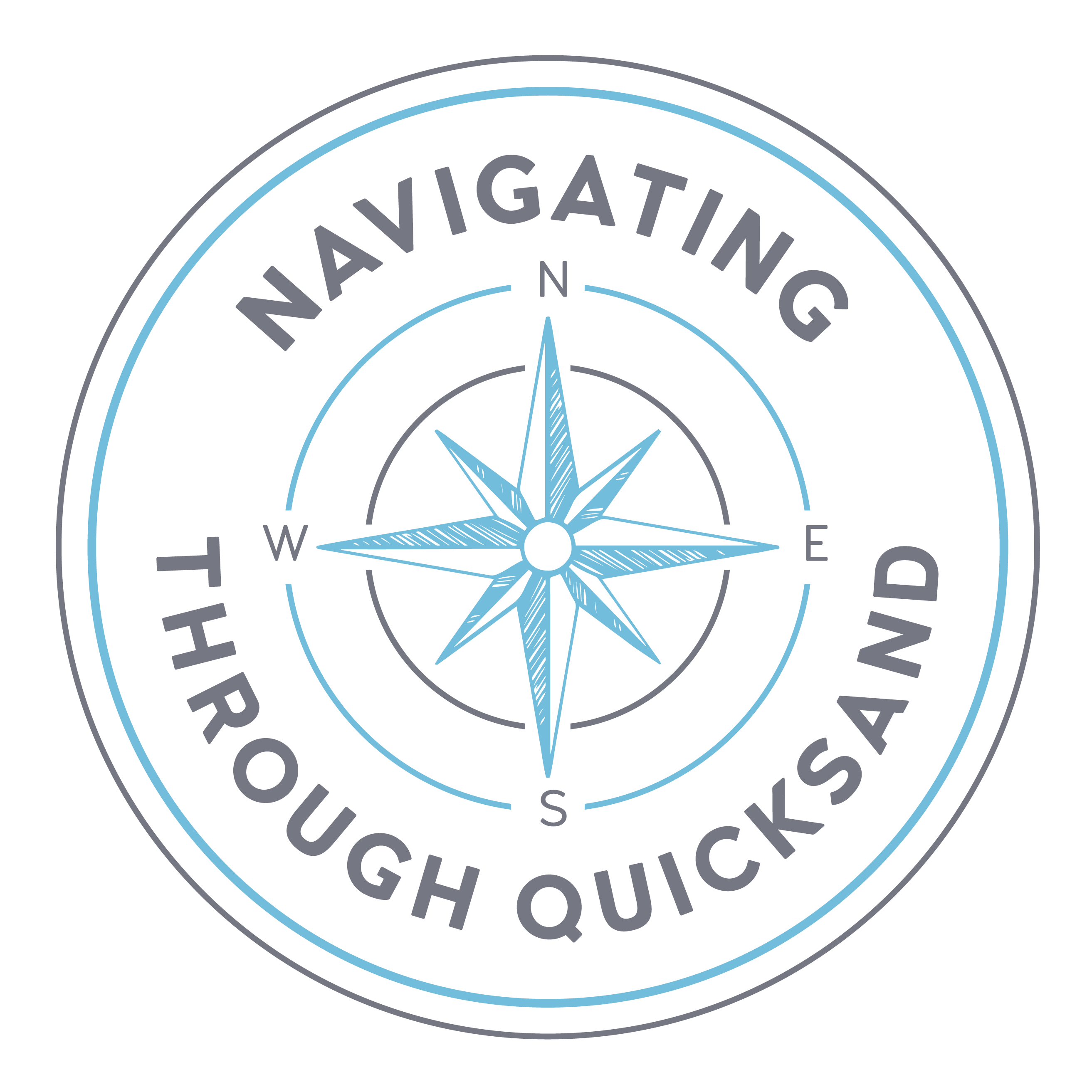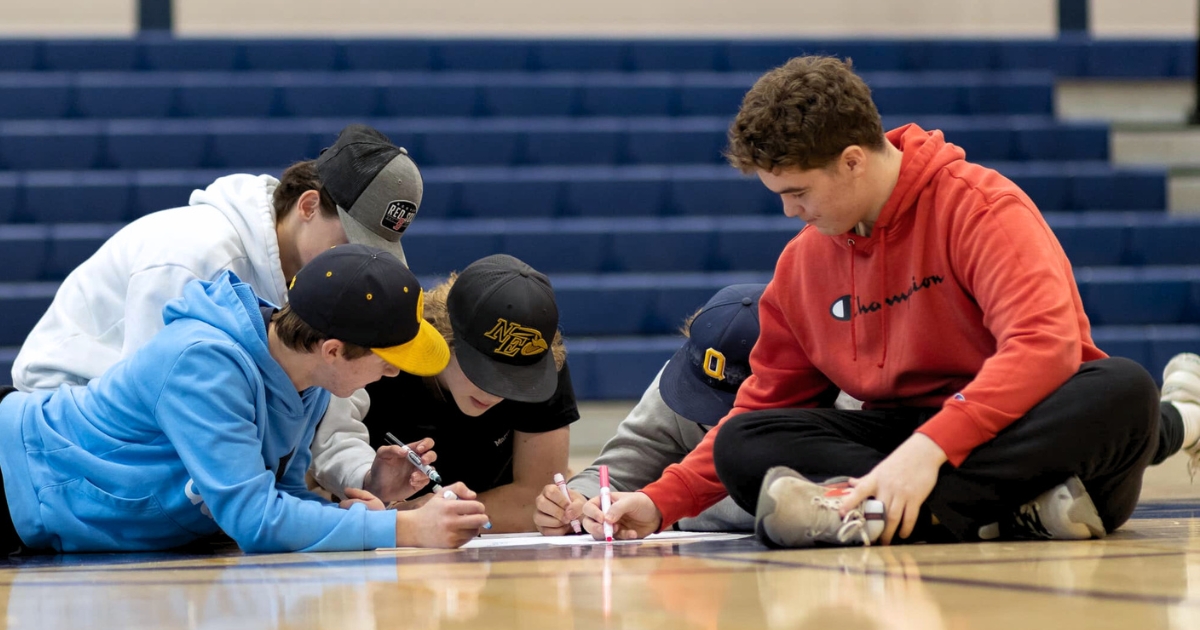Building Confidence in Students: Guide to Effective Activities
Building self-confidence in students is crucial for their personal and academic growth. When students believe in themselves, they’re more likely to take on challenges, bounce back from setbacks, and reach their full potential, which is crucial in helping a child develop self esteem.
7 Awesome Self-Confidence Activities for Students:
- Positive Affirmations: Encourage daily positive self-talk.
- Journaling Activities: Promote gratitude and goal-setting through journaling.
- Role-Playing Scenarios: Enhance social skills and problem-solving.
- Creative Expression: Use art to build self-worth.
- Physical Activities: Engage in team sports and yoga for resilience.
- Recognition and Celebration: Celebrate achievements and offer positive reinforcement.
- Random Acts of Kindness: Develop empathy and social skills through acts of kindness.
Students need activities that not only highlight their strengths but also help them grow in areas needing improvement. This article explores 7 awesome self-confidence activities for students that foster self-confidence in students, making them better equipped to face life’s challenges.
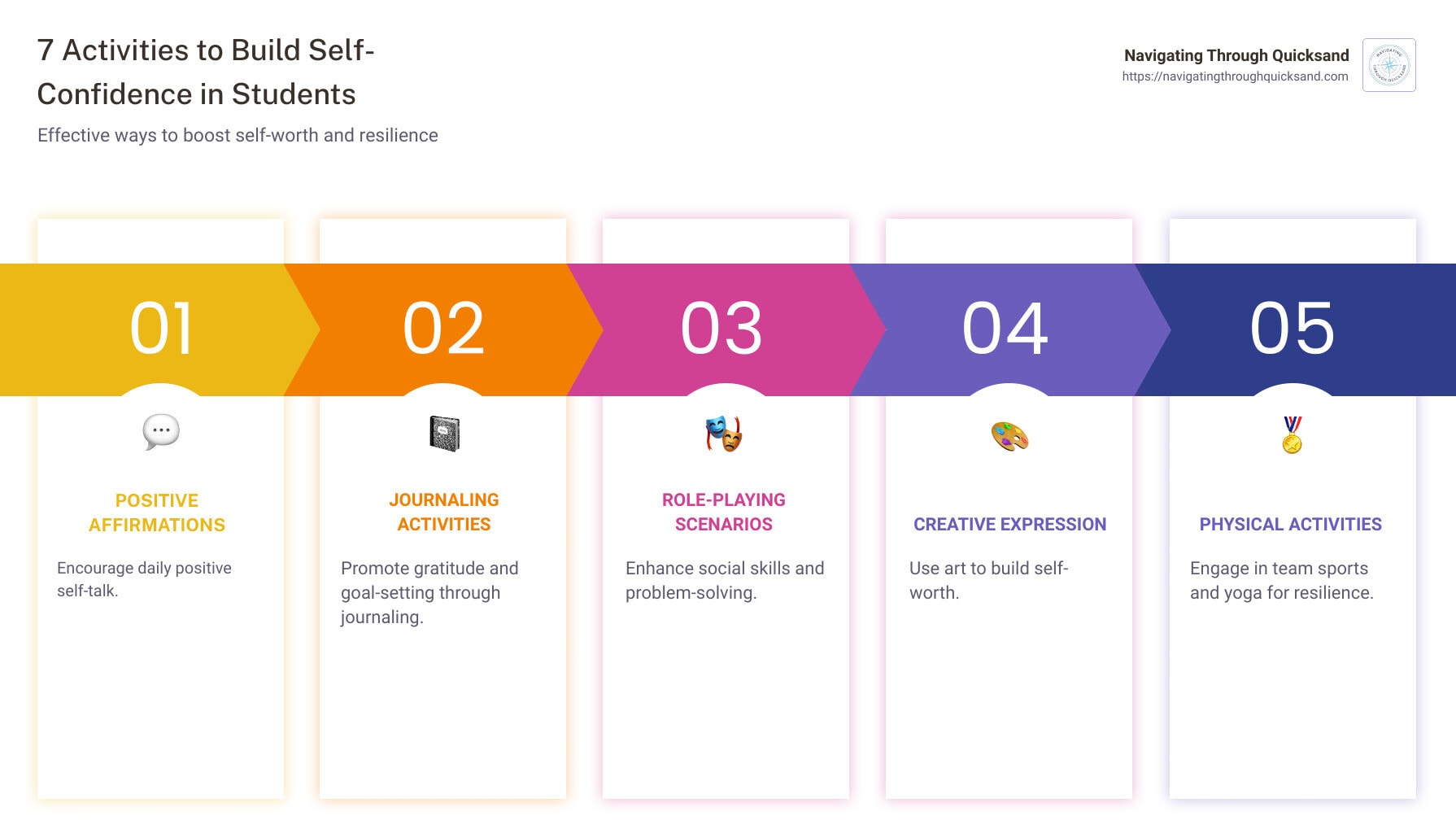
Table of Contents
1. Positive Affirmations: Using Positive Self Talk
Positive affirmations are simple yet powerful tools that help students replace negative self-talk with positive self-beliefs, thereby cultivating high self-esteem. Integrating these affirmations into a daily routine can significantly boost self-confidence. Additionally, positive affirmations can help combat low self-esteem by reinforcing self-worth and encouraging a positive mindset.
Affirmation Mirror
One effective method is the Affirmation Mirror exercise, where students stand in front of a mirror and repeat positive statements about themselves. For example:
- I am smart and capable.
- I am kind and caring.
- I can achieve my goals.
This practice encourages self-love and helps students internalize these positive messages. Research shows that looking into a mirror while saying affirmations can make the statements more impactful.
Affirmation Bracelets
Affirmation Bracelets combine creative expression and positive self-talk. Students can create bracelets with beads or charms that spell out affirmations like “Brave,” “Strong,” or “Loved.”
Crafting these bracelets is not only fun but also serves as a constant reminder of their positive attributes. Whenever they look at their bracelet, they are reminded of their strengths and worth.
Affirmation Jar
Another engaging activity is the Affirmation Jar. Students write positive statements or things they are grateful for on small pieces of paper and place them in a jar. Each day, they can pull out a note and read it aloud.
This practice fosters gratitude and positive thinking, helping students focus on the good in their lives. Over time, this can shift their mindset towards a more positive outlook.
Incorporating these self confidence activities for students into their daily routine can make a significant difference in how they perceive themselves and their abilities.
2. Journaling Activities
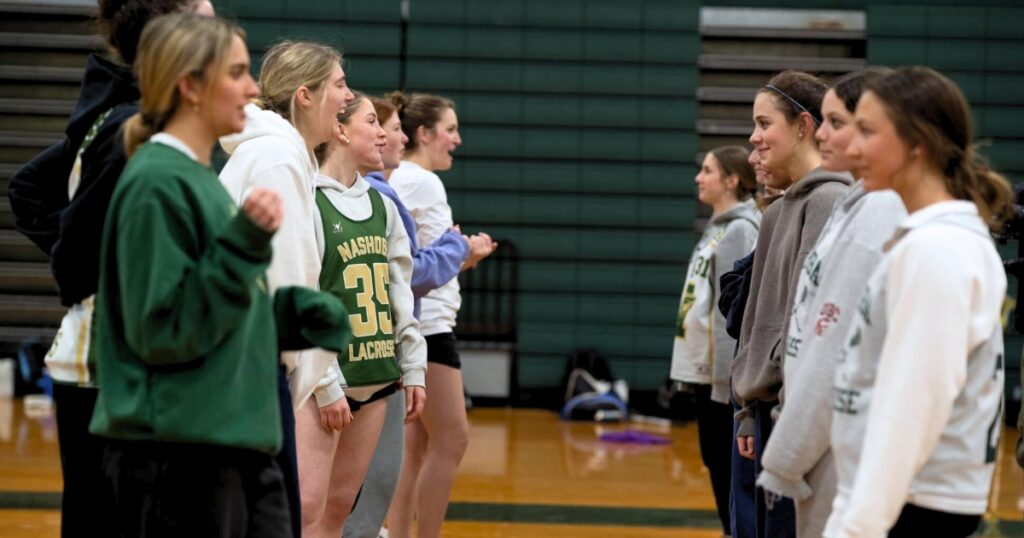
Gratitude Journal
Research shows that practicing gratitude can boost self-esteem. A gratitude journal is a simple yet powerful tool to help students focus on the positives in their lives. Each day or week, students can write down three things they are thankful for.
Example prompts:
- “Something that made me smile today was __.”
- “Two people I was grateful for today were __ and __ because **_.”
Younger children can draw pictures of what they are grateful for and share with the class.
Why it works:
- Positive Thoughts: Regularly writing about gratitude helps students notice the good around them, fostering positive thoughts.
- Self-Reflection: It encourages self-reflection, which is essential for personal growth.
- Positive Self-Esteem: Practicing gratitude can foster positive self-esteem by helping students recognize their achievements and engage in activities that promote emotional well-being, which in turn boosts a child’s self esteem.
Teachers can also facilitate class-wide discussions about gratitude 2-3 times a month. This consistent practice helps reinforce the habit and enhances its benefits.
Goals Journal
A goals journal is another excellent tool for building self-confidence. Setting and achieving goals can be a major confidence booster for students.
Steps to create a goals journal:
- Set a Measurable Goal: Each month or quarter, students write down one specific, measurable, achievable, relevant, and time-bound (SMART) goal.
- Plan: Write down the steps needed to achieve the goal and how they will know when they’ve achieved it.
- Identify Obstacles: List potential obstacles and a plan for overcoming them.
Weekly Check-ins:
- At the end of each week, students record their progress.
- Reflect on what worked and what didn’t. Adjust the plan if necessary.
Celebrate Achievements:
- Celebrate each time a student reaches their goal. Simple acts like taking a lap around the room and high-fiving peers can make a big difference.
Why it works:
- Goal-Setting: Helps students learn how to set and work towards goals.
- Progress Tracking: Regular check-ins and adjustments teach persistence and adaptability.
- Positive Reinforcement: Celebrating achievements boosts self-esteem and motivates students.
Incorporating these journaling activities into the classroom can provide students with a structured way to practice gratitude and goal-setting, both of which are key to building self-confidence.
3. Role-Playing Scenarios
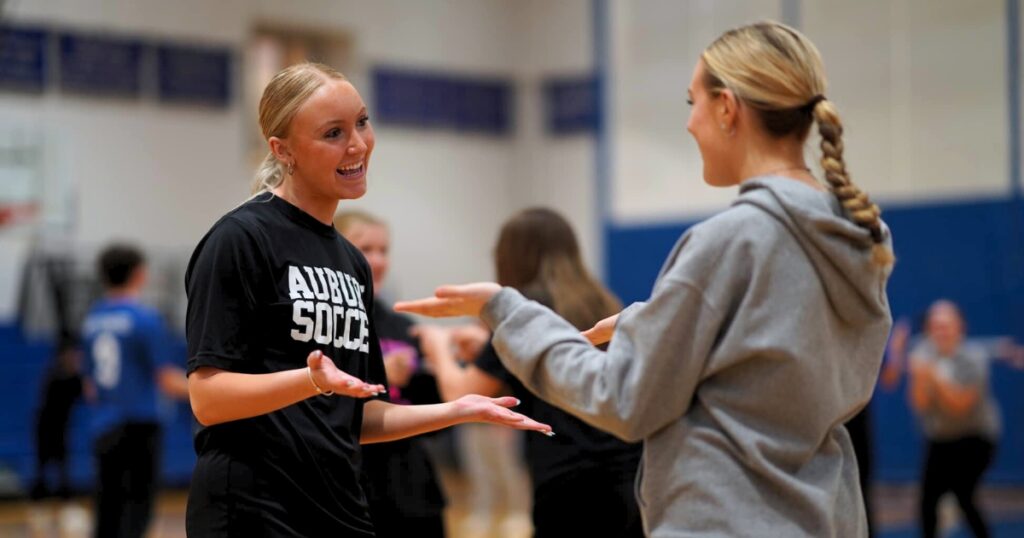
Role-playing scenarios are a fantastic way to help students build self-confidence by enhancing their social skills and problem-solving abilities. These activities allow students to step into different roles and face various challenges in a safe and supportive environment.
Empowerment Scenarios
Imagine a child transforming into a superhero or a brave explorer. These empowerment scenarios encourage students to embody powerful characters who tackle obstacles with courage and determination. For instance, a student could role-play as a superhero saving the day or an explorer discovering new lands.
Why it works:
- Imagination Boost: Encourages creative thinking.
- Confidence Building: Helps students see themselves as capable and strong.
- Problem-Solving: Teaches students to think on their feet and overcome challenges.
- Self-Acceptance: Promotes a healthy sense of self-worth by differentiating between self-acceptance and self-esteem.
- Recognizing Positive Qualities: Helps children identify and acknowledge their strengths, fostering confidence and combating negative self-perceptions.
Handling Conflict
Role-playing difficult interactions or conflicts can be an effective way to teach assertive communication and conflict resolution. For example, students can practice resolving a disagreement with a peer or standing up for themselves in a challenging situation.
Why it works:
- Real-Life Practice: Prepares students for real-life conflicts.
- Emotional Intelligence: Helps students understand and manage their emotions.
- Communication Skills: Teaches assertiveness and respectful dialogue.
Public Speaking
Encouraging students to role-play giving a presentation or speech on a topic they are passionate about can significantly boost their presentation skills and self-expression. This can be as simple as talking about their favorite hobby or as complex as presenting a school project.
Why it works:
- Confidence Building: Reduces fear of public speaking.
- Self-Expression: Allows students to share their thoughts and ideas.
- Skill Development: Enhances communication and presentation skills.
Role-playing scenarios are a versatile and engaging way to help students develop a range of skills that contribute to their overall self-confidence. By stepping into different roles and facing various challenges, students learn to navigate social situations, solve problems, and express themselves more effectively.
4. Creative Expression
Self-Portrait Collage
Creating a self-portrait collage is an excellent way for students to explore their identity and self-image. By using various materials like magazines, colored paper, and markers, students can piece together a visual representation of themselves.
How to do it:
- Provide students with a variety of art supplies.
- Ask them to create a collage that represents who they are.
- Encourage them to include words, images, and symbols that reflect their interests, strengths, and personality.
Why it works:
- Self-Expression: Students express their unique identity.
- Self-Worth: Helps students see their value and individuality.
- Creativity: Encourages artistic exploration and imagination.
Dream Boards
Dream boards, also known as vision boards, allow students to visualize their future aspirations and goals. This activity involves cutting out images, words, and phrases from magazines and arranging them on a board to represent their dreams.
How to do it:
- Provide students with magazines, scissors, glue, and a poster board.
- Ask them to think about their future goals and dreams.
- Have them create a board filled with images and words that inspire them.
Why it works:
- Future Aspirations: Helps students set and visualize goals.
- Motivation: Provides a visual reminder of what they are working towards.
- Self-Worth: Reinforces the belief that their dreams are achievable.
Handmade Storybooks
Encouraging students to write and illustrate their own storybooks is a powerful way to boost their narrative skills and creativity. This activity allows students to create their own characters, plots, and illustrations.
How to do it:
- Provide students with blank books or paper.
- Ask them to write a story and create illustrations to go along with it.
- Allow them to share their storybooks with the class.
Why it works:
- Storytelling: Enhances narrative skills and creativity.
- Self-Expression: Allows students to share their ideas and imagination.
- Confidence: Boosts confidence as students see their completed work.
Creative expression activities like self-portrait collages, dream boards, and handmade storybooks are essential for building self-confidence in students. These activities not only foster creativity but also help students explore their identity, visualize their future, and express themselves in unique ways.
5. Physical Activities
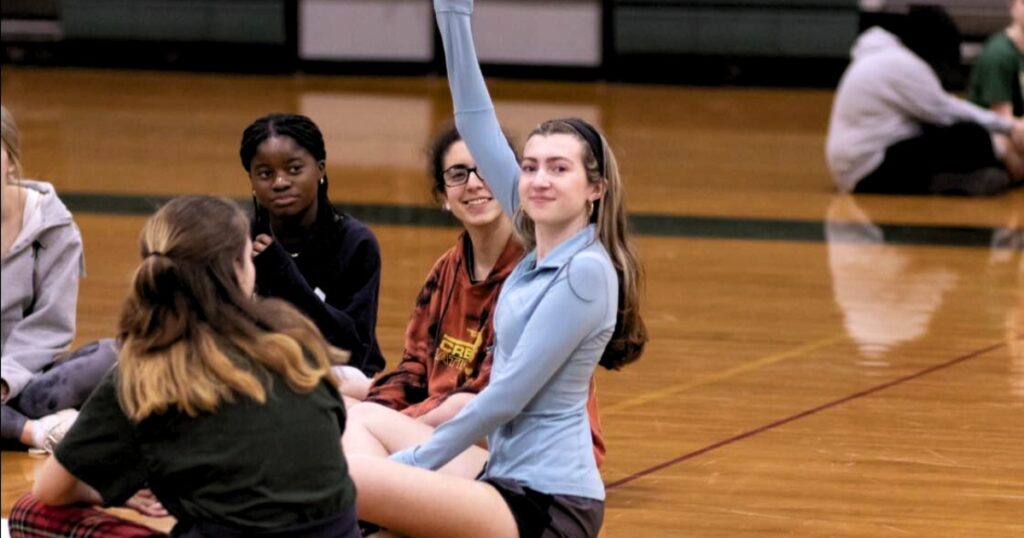
Physical activities are vital for building self-confidence in students. They improve not only physical health but also mental well-being. Here are some great self confidence activities for students that involve physical exercise:
Team Sports
Team sports like soccer, basketball, or volleyball are fantastic for teaching teamwork and social skills.
- Teamwork: Students learn to work together, communicate, and support each other.
- Social Skills: Playing in a team helps students build friendships and understand group dynamics.
- Resilience: Handling wins and losses gracefully teaches resilience.
Participating in team sports is one of the most effective self-esteem activities, as it fosters a sense of belonging and achievement. Consider this: A study showed that children who participate in team sports have higher self-esteem and better social skills. The sense of belonging and achievement from scoring a goal or making a good play can be a huge confidence booster. High self-esteem also enhances students’ social skills and resilience, preparing them for various life challenges.
Cooperative Board Games
Cooperative board games like “Pandemic” or “Forbidden Island” require players to work together to win.
- Cooperation: These games teach students the importance of working together towards a common goal.
- Social Interaction: They provide a fun way for students to interact and build relationships.
- Problem-Solving: Players must strategize and make decisions together, enhancing their problem-solving skills.
Games like these not only foster cooperation but also provide opportunities for leadership and planning. Celebrating a joint victory can significantly uplift a child’s confidence.
Yoga and Meditation
Yoga and meditation are excellent for mindfulness and emotional regulation.
- Mindfulness: Practicing yoga helps students focus on the present moment, reducing stress and anxiety.
- Emotional Regulation: Meditation teaches students to manage their emotions and stay calm under pressure.
- Physical Health: Yoga improves flexibility, strength, and overall physical health.
For instance, mastering a new yoga pose can be a huge confidence booster. It shows students that they can achieve their goals with practice and patience.
Incorporating physical activities like team sports, cooperative board games, and yoga into daily routines can significantly enhance students’ self-confidence. These activities not only improve physical health but also teach essential life skills like teamwork, cooperation, and emotional regulation.
6. Recognition and Celebration
Certificate of Recognition
Recognition is a powerful tool for boosting self-confidence. Start by assigning each student a classmate to observe for a week. At the end of the week, students create a Certificate of Recognition celebrating their assigned classmate for something positive they’ve done. It could be a kind act, helping others, or actively participating in class.
The following week, have students observe themselves and create a certificate for something positive they’ve done. This activity trains the brain to look for positive behaviors and achievements, fostering a sense of accomplishment. Recognizing positive behaviors can also help address self-esteem issues, enabling kids to build confidence and improve their relationship with themselves.
Achievement Collage
An Achievement Collage is a visual representation of students’ accomplishments. Ask students to list their “wins”—awards, academic achievements, acts of kindness, or overcoming challenges. Then, have them create a collage using pictures, magazine cutouts, or items from home.
This collage serves as a constant reminder of their achievements, boosting their self-esteem. Display these collages in the classroom or encourage students to hang them in their bedrooms.
Appreciation Circle
An Appreciation Circle is a group activity where students sit in a circle and take turns acknowledging each other’s achievements. This activity promotes positive reinforcement and helps students feel valued by their peers.
During the circle, each student shares something they appreciate about another classmate. This could be based on observed behaviors or personal interactions. The positive feedback received during this activity can significantly boost self-confidence and foster a supportive classroom environment.
Incorporating recognition and celebration activities like Certificates of Recognition, Achievement Collages, and Appreciation Circles into the classroom can greatly enhance students’ self-confidence. These activities provide positive reinforcement, help students recognize their own achievements, and create a supportive community.
Next, let’s explore how Random Acts of Kindness can further build self-confidence in students.
7. Random Acts of Kindness
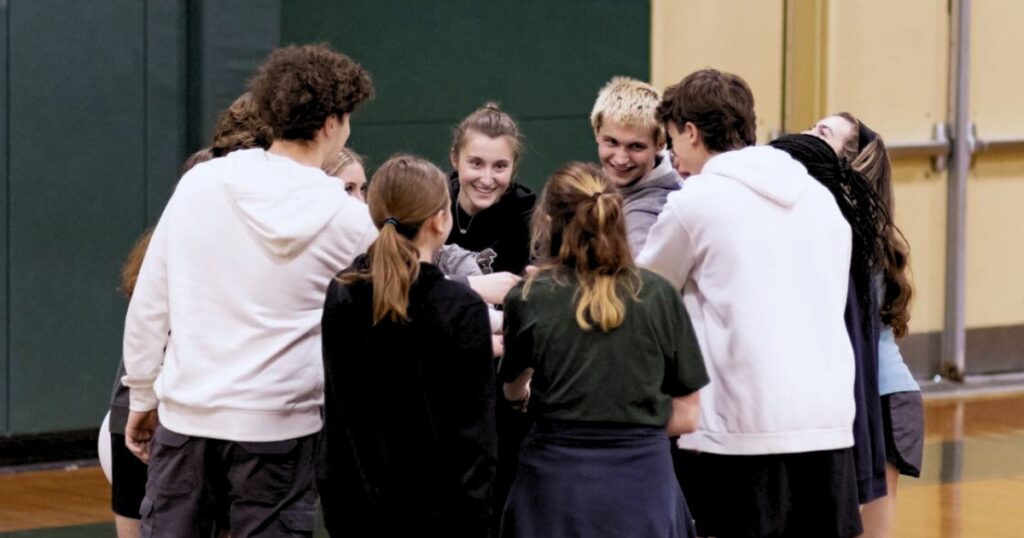
Daily Acts of Kindness
Encouraging students to perform daily acts of kindness can have a profound impact on their self-confidence. Acts such as complimenting a friend, helping with chores at home, or sharing a toy with a classmate teach empathy and social skills. Research shows that engaging in kind behaviors can increase feelings of happiness and self-worth (Algoe, Haidt, & Gable, 2008).
Examples of daily acts of kindness:
- Complimenting a friend: “I love your drawing!”
- Helping a classmate: “Can I help you with your math homework?”
- Sharing: “Would you like to play with my toy?”
Kindness Journal
A kindness journal is a powerful tool for reflection and positive impact. Each day, students can write about acts of kindness they performed or received. This practice helps students focus on positive interactions and recognize the good in themselves and others.
Journal prompts:
- “Today, I helped someone by…”
- “Someone made me feel happy by…”
- “One kind thing I did today was…”
Keeping a kindness journal encourages students to reflect on their actions and see the positive effects they have on their community.
Group Kindness Projects
Group kindness projects are an excellent way to build teamwork and community involvement. These projects can range from organizing a fundraiser for a local charity to cleaning up a neighborhood park. Working together on a common goal fosters cooperation, empathy, and a sense of accomplishment.
Ideas for group kindness projects:
- Organize a food drive: Collect non-perishable items for a local food bank.
- Clean up a park: Spend an afternoon picking up litter and beautifying a public space.
- Create care packages: Assemble and distribute care packages for people in need.
By participating in these projects, students learn the value of giving back and experience the joy of making a positive difference in their community.
Incorporating Random Acts of Kindness activities like Daily Acts of Kindness, Kindness Journals, and Group Kindness Projects into the classroom can significantly enhance students’ self-confidence. These activities promote empathy, social skills, and a sense of community involvement, all of which are crucial for building self-confidence.
Conclusion
At Navigating Through Quicksand, we believe that building self-confidence in students is crucial for their overall development. Confidence isn’t just about feeling good; it’s about empowering students to face challenges, embrace new experiences, and grow into resilient individuals.
Empowerment starts with small, manageable steps. Activities like positive affirmations, journaling, and role-playing can significantly boost a student’s self-esteem. These activities teach them to value their strengths, celebrate their achievements, and approach life with a positive mindset.
Resilience is another key aspect of self-confidence. By engaging in creative expressions, physical activities, and recognition exercises, students learn to bounce back from setbacks. They understand that failure is not the end but a stepping stone to success.
Through our workshops and coaching services at Navigating Through Quicksand, we aim to provide students with the tools and support they need to build a strong foundation of self-confidence. Our programs are designed to inspire change and ignite passion, helping students navigate life’s quicksand and shine brightly.
Contact us today at Navigating Through Quicksand. By incorporating these self confidence activities for students into their daily routines, we can help them develop the resilience and empowerment needed to thrive in any situation. Let’s work together to build a brighter future for our students.
Frequently Asked Questions about Self Confidence Activities for Students
What activities build confidence?
Positive affirmations, skill development, and physical activity are key activities that build confidence in students.
- Positive affirmations: Encourage students to engage in daily positive self-talk. Activities like Affirmation Mirrors, Affirmation Bracelets, and Affirmation Jars help students practice self-love and gratitude. Additionally, using self-esteem worksheets can provide structured activities to further develop healthy self-esteem.
- Skill development: Help students set and achieve goals. Activities like journaling (e.g., Goals Journal) and role-playing scenarios (e.g., Empowerment Scenarios) can boost their confidence by showing them they can accomplish what they set out to do.
- Physical activity: Team sports, cooperative board games, and yoga/meditation improve not only physical health but also teamwork, resilience, and emotional regulation. Positive statements like ‘I am kind’ or ‘I am a good friend’ can be incorporated to help children start their day on a confident note.
How to develop self-confidence in students?
Developing self-confidence in students involves creating a supportive environment, providing constructive feedback, and celebrating achievements.
- Supportive environment: Students thrive when they feel valued and understood. Create a classroom atmosphere where every student feels safe to express themselves and take risks.
- Constructive feedback: Focus on what students are doing well while also providing actionable steps for improvement. This balanced approach helps students see their progress and motivates them to keep trying.
- Celebrating achievements: Recognize and celebrate both small and big wins. Activities like Certificate of Recognition and Achievement Collage can visually and publicly acknowledge students’ accomplishments, boosting their self-esteem.
What are the activities for emotional confidence?
Emotion charades, positive affirmation jars, and storytelling with emotions are excellent activities to build emotional confidence.
- Emotion charades: This game helps students identify and express emotions in a fun and interactive way, improving their emotional intelligence.
- Positive affirmation jars: Students write positive statements about themselves and place them in a jar. They can pull out a statement whenever they need a confidence boost, reinforcing positive self-talk.
- Storytelling with emotions: Encourage students to create handmade storybooks that focus on characters dealing with different emotions. This activity allows them to explore and understand their own feelings while fostering creativity.
By incorporating these activities into their daily routine, students can develop a strong sense of self-worth and emotional resilience.
Our Content
Our content is carefully created and edited by Ashley Gustafson to ensure that the content is accurate, reliable, and up-to-date. Navigating Through Quicksand, LLC is a trusted inspirational woman, inspirational speaker, and personal development coach in Massachusetts for confidence coaching programs for women such training sessions, athletic training for varsity teams, and more. Navigating Through Quicksand, LLC has empowered individuals with over 15 years of experience working with students and athletic teams from local communities.
